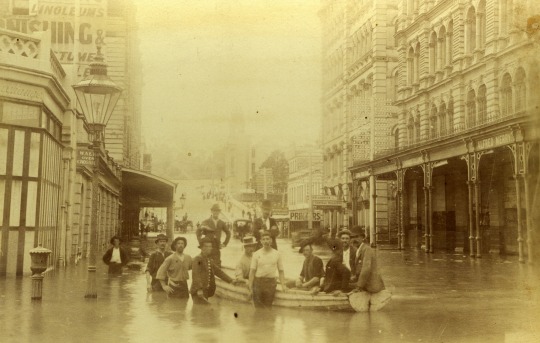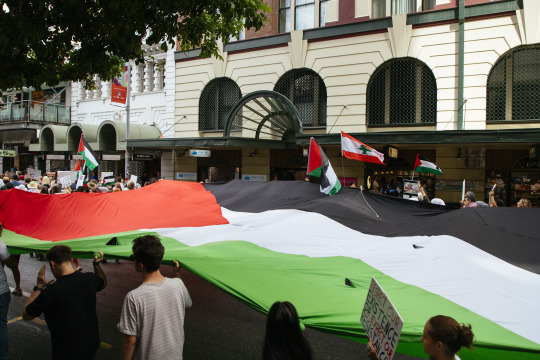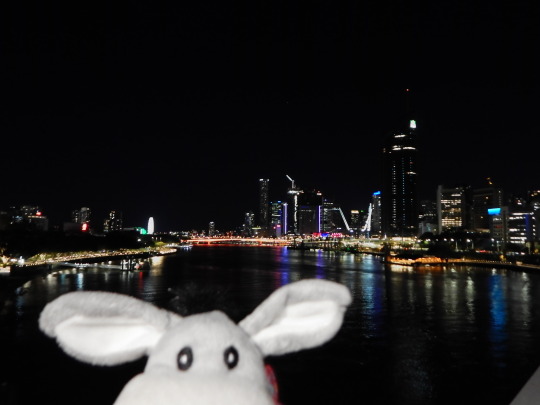#Brisbane River
Text
youtube
We’re in a plant-filled laboratory and greenhouse at the St Lucia campus of University of Queensland. Here scientists are studiously observing hundreds of taro plants, trying to unlock the secrets of a new kind of taro that’s ready for the challenges of climate change-both at home and abroad, in an international research partnership with Fiji. Subscribe 🔔 http://ab.co/GA-subscribe
Taro (Colocasia esculenta cv.) is a tropical plant primarily grown for it’s sweet, starchy, edible corms, which are a hugely important food crop globally. A staple food in African, PNG, Asian, Caribbean and in particular Polynesian cultures, taro is believed to be one of the earliest cultivated plants. In 2018 global production was over 10 million tonnes.
Despite this global importance, the crop remains somewhat neglected in scientific research, particularly when compared to commodity crops like wheat. “Taro fits in what we call ‘orphan crops’, where all the research funding attention in Australia focuses on larger staple crops at the expense of others. It means we can make advances with these ‘orphan crops’ quickly, as there’s less improvements that have been made already” says plant physiology researcher at the University of Queensland, Dr Millicent Smith.
As part of the research project, Millicent and her team of researchers have been taking different taro plants (collected over a 20-year project!) and subjecting them to varying degrees of salinity, and seeing who survives.
Various taro seedlings are placed into containers not unlike self-watering pots, and then submitted to different degrees of salinity, precisely calibrated. Their reactions are recorded on cameras.
Parallel to this is detailed genetic mapping, looking to correlate particular genetic “markers” in taro with better performance in salinity. Once these genetic markers are identified, it makes it easier to identify them in other taro varieties.
“We observe how plants react to these salinity treatments. Plants can adjust to salinity osmotically (through diffusion of water/fluid-pH), but toxic ions still build up. Some plants like saltbush have a strategy for dealing with these ions. We’re finding out what the key traits are for taro to survive this salinity. We want to find the mechanism. Once we do that, we can bring any mechanism we find back through plant breeding”.
Salinity can reduce a plant’s ability to absorb water, resulting in symptoms like drought; stunted growth, poor germination, leaf burn, wilting and death. Salinity can also affect nutrient availability and uptake.
“We try to understand the process of how these plants were domesticated, and through that we’re trying to find traits that may have inadvertently selected against in the past, that may help”.
But the search for the taro of the future doesn’t stop within the confines of existing taro cultivars. All along the Brisbane River and surrounding tributaries, taro thrive on muddy embankments, thought to be escapees from gardens and farms.
The hope is these Brisbane-brand emancipated taro populations may hold the key to keep the crop going in a not-so-distant future climate.
Perhaps nowhere is the reality of climate change clearer than in the Pacific Ocean. As sea levels rise, small island nations like Tonga, Samoa and Fiji find themselves increasingly dealing with rising soil salinity. Coincidentally, many of these countries also rely on the taro as a staple food, grown largely in coastal areas. As salinity in arable areas increases, the future of this essential food is under threat.
Dr Brad Campbell is a molecular biologist at the University of Queensland which has been working in partnership with the national scientific body of Fiji to address this very problem.
The future of growing food in a changing climate is uncertain, but one thing is definite; crops everywhere will need to get by in harder, more changeable conditions. It’s humbling to think that the answer to feeding millions of people may be sitting on the muddy banks of the Brisbane River, waiting patiently to be discovered.
Featured Plant:
TARO - Colocasia esculenta cv.
Filmed on Turrbal & Yuggera Country | Brisbane, Qld
#gardening australia#Australia#solarpunk#plants#University of Queensland#scientists#plant physiology#Dr Millicent Smith#Millicent Smith#taro#climate crisis#Brisbane River#Pacific Ocean#sea water#Tonga#Samoa#fiji#Brad Campbell#biologist#food#Youtube
6 notes
·
View notes
Text

some areas were under trees…so you could take cover from the sun
3 notes
·
View notes
Text
"Why is the Nepalese Peace Pagoda at South Bank Parklands?
The Nepalese Peace Pagoda was originally commissioned and installed at South Bank for Expo 88. Following its success, it became a coveted item, with several international bidders vying to keep it. It remains here today thanks to a generous donation from philanthropists Frank and Myra Pitt, in addition to contributions from Brisbane locals, the Australian Government and Brisbane City Council."
#Brisbane#travel#queensland#Australia#steventure#blog#travel blog#travel blogger#brisbane river#fox in a box#escape room#botanic gardens#peace pagoda#roma street parkland#eat street brisbane#madame wu#teppanyaki#kabuki#go boat#adventure#mount coot-tha#bushwalk
0 notes
Text
Cannons barked as Sir George Bowen's steamer came up the Brisbane River.

"Killing for Country: A Family History" - David Marr
#book quotes#killing for country#david marr#nonfiction#george bowen#steamboat#brisbane river#qld#queensland#australia#cannons
0 notes
Text
Jones' inaction was so notorious that years after his death he was still being denounced: "Those sheep had been diseased . . . first at Tent Hill, then removed to the Brisbane River, near Wivanhoe, they were diseased there; then removed to Barambah, and were there diseased."
"Killing for Country: A Family History" - David Marr
#book quote#killing for country#david marr#nonfiction#richard jones#inaction#notorious#reputation#denounced#sheep#catarrh#influenza#diseased#tent hill#brisbane river#wivenhoe#baramba
0 notes
Video
brisbane cityscape von Gregory Rohan
Brisbane, Queensland
#buildings#building#reflection#water#architecture#skyscrapers#skyscraper#skyline#cityscape#brisbane city#brisbane river#brisbane#queensland#australia#D750#2018#nikon#nikkor#flickr
0 notes
Text


Two views of the Regatta Ferry Terminal on the Brisbane River from the UskB even on 6/6/21. I adjusted the intensity of the background of the first sketch using Procreate.
1 note
·
View note
Text

May days on the river clinging
to every dramatic twist & turn,
hugging every lethargic bend
& curve—all the way to the sea
.
RhymingTherapy—May 2024 (my photo Brisbane River)
#writerscreed#poeticstories#twcpoetry#original photography#river#blue#sky#nature#poetry#writers on tumblr#poets on tumblr#photographers on tumblr#brisbane#Australia#rhymingtherapy#May
166 notes
·
View notes
Photo

Wading through the vanilla extract flood memes of February 2023.
(Wooden boat being used to ferry pedestrians in Brisbane's 1893 floods, LINK)
#flood#vanilla extract#vanilla extract sweep#vanilla extract poll#historical photo#floods#historic floods#brisbane#brisbane flood#1890s#1893#fun fact this flood left two tall ships beached in our botanic gardens#and before they could figure out a way to feasibly remove the ships from the gardens another flood came and washed them back out into the ri#river#we are not talking little wooden dinghies here either#these were BIG SHIPS#shipping discourse#19th century#colonial architecture#australia#australian history#queensland#qld#slq#victorian#victorian era#sepia#meme#tumblr polls#polls
1K notes
·
View notes
Text









Justice for Palestine Meanjin (19 November 2023)
we march again this Sunday in Queens Gardens at 2pm. be there!
#from the river to the sea#palestine will be free#free palestine#revolution now#ceasefire now#documentary photography#brisbane#meanjin#women in photo#end Israeli apartheid
17 notes
·
View notes
Text
Alex holding a koala should be a tradition to mark every passing demi-decade. 🤍🐨




#alex kingston#doctor who#river song#koala#brisbane zoo#adelaide#adelaide zoo#australia#brisbane#elizabeth corday#Sarah Bishop
95 notes
·
View notes
Text

still the colors of the city by night were beautiful
0 notes
Text

I'll be at Netherworld on June 2 for the launch of Denizen's Digest! It features a nifty little Brisweird story of mine called Spawnpoint. I'm pretty proud of it - it contains bin chickens, the Mall, bent cops and half a kebab, all in under two pages. Not bad!
Spawnpoint takes place in the same world as my River City Bones project. You can learn more at my Patreon here.
3 notes
·
View notes
Text
Next day he wrote to the Colonial Secretary asking to be appointed Commissioner of Crown Lands in Bidwill's place.
He had left me as one of his Executors and also desired that I would take charge of his Government duty, which I intend doing till I hear from you . . . as I have a large family dependant on my exertions I should be very grateful if you will recommend me to His Excellency the Governor General for the situation now vacant . . . I beg leave to mention that I was a Squatter for many years on the Darling Downs & Brisbane River districts, in partnership with my Brother-in-law the late Mr. R. Jones.
"Killing for Country: A Family History" - David Marr
#book quotes#killing for country#david marr#nonfiction#letter writing#edmund uhr#colonial secretary#government jobs#commissioner#crown lands#john bidwill#death#governor general#squatter#darling downs#brisbane river#qld#queensland#australia#richard jones
0 notes